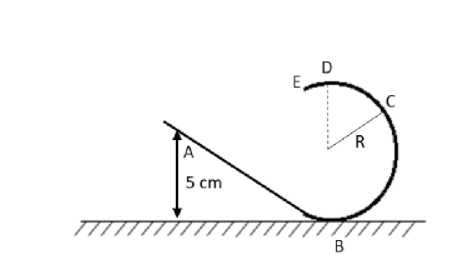Answer
385.2k+ views
Hint:Use the formula for kinetic energy of an object and potential energy of an object. Use the formula for velocity of an object at the bottom of the vertical circle. Apply law of conservation of energy at the points A and B of the track ABCDE and determine the value of radius necessary for the body to complete the circular loop.
Formulae used:
The kinetic energy \[K\] of an object is
\[K = \dfrac{1}{2}m{v^2}\] …… (1)
Here, \[m\] is the mass of the object and \[v\] is the velocity of the object.
The potential energy \[U\] of an object is
\[U = mgh\] …… (2)
Here, \[m\] is the mass of the object, \[g\] is acceleration due to gravity and \[h\] is the height of the object from the ground.
Complete step by step answer:
We have given that a body at point A moves on the track ABCDE. The track forms a circular loop of radius \[R\].
Initially at point A, the height of the body from ground is \[5\,{\text{cm}}\].
\[h = 5\,{\text{cm}}\]
We are asked to determine the radius \[R\] of the circular track so that the body completes the circular loop.
The potential energy of the body at point A is given by
\[{U_A} = mgh\]
Substitute \[5\,{\text{cm}}\] for \[h\] in the above equation.
\[{U_A} = mg\left( {5\,{\text{cm}}} \right)\]
\[ \Rightarrow {U_A} = 5mg\]
The velocity of the body to complete the circular loop at point B should be
\[{v_B} = \sqrt {5gR} \]
The kinetic energy of the body at the bottom point B of the circular loop is given by
\[{K_B} = \dfrac{1}{2}mv_B^2\]
Substitute \[\sqrt {5gR} \] for \[{v_B}\] in the above equation.
\[{K_B} = \dfrac{1}{2}m{\left( {\sqrt {5gR} } \right)^2}\]
\[ \Rightarrow {K_B} = \dfrac{{5mgR}}{2}\]
We know that according to the law of conservation of energy, the potential energy of body at point A must be equal to the kinetic energy of the body at point B.
\[{U_A} = {K_B}\]
Substitute \[5mg\] for \[{U_A}\] and \[\dfrac{{5mgR}}{2}\] for \[{K_B}\] in the above equation.
\[5mg = \dfrac{{5mgR}}{2}\]
\[ \Rightarrow R = 2\,{\text{cm}}\]
Therefore, the radius of the circular loop should be \[2\,{\text{cm}}\].
Hence, the correct option is A.
Note:The students should keep in mind that the kinetic energy of the body is zero when it starts from point A as it starts from rest and the potential energy of the body at point B is zero as the height of the body at point B is zero from the ground. Hence, the potential energy of the body at point A is equal to kinetic energy at point B.
Formulae used:
The kinetic energy \[K\] of an object is
\[K = \dfrac{1}{2}m{v^2}\] …… (1)
Here, \[m\] is the mass of the object and \[v\] is the velocity of the object.
The potential energy \[U\] of an object is
\[U = mgh\] …… (2)
Here, \[m\] is the mass of the object, \[g\] is acceleration due to gravity and \[h\] is the height of the object from the ground.
Complete step by step answer:
We have given that a body at point A moves on the track ABCDE. The track forms a circular loop of radius \[R\].
Initially at point A, the height of the body from ground is \[5\,{\text{cm}}\].
\[h = 5\,{\text{cm}}\]
We are asked to determine the radius \[R\] of the circular track so that the body completes the circular loop.
The potential energy of the body at point A is given by
\[{U_A} = mgh\]
Substitute \[5\,{\text{cm}}\] for \[h\] in the above equation.
\[{U_A} = mg\left( {5\,{\text{cm}}} \right)\]
\[ \Rightarrow {U_A} = 5mg\]
The velocity of the body to complete the circular loop at point B should be
\[{v_B} = \sqrt {5gR} \]
The kinetic energy of the body at the bottom point B of the circular loop is given by
\[{K_B} = \dfrac{1}{2}mv_B^2\]
Substitute \[\sqrt {5gR} \] for \[{v_B}\] in the above equation.
\[{K_B} = \dfrac{1}{2}m{\left( {\sqrt {5gR} } \right)^2}\]
\[ \Rightarrow {K_B} = \dfrac{{5mgR}}{2}\]
We know that according to the law of conservation of energy, the potential energy of body at point A must be equal to the kinetic energy of the body at point B.
\[{U_A} = {K_B}\]
Substitute \[5mg\] for \[{U_A}\] and \[\dfrac{{5mgR}}{2}\] for \[{K_B}\] in the above equation.
\[5mg = \dfrac{{5mgR}}{2}\]
\[ \Rightarrow R = 2\,{\text{cm}}\]
Therefore, the radius of the circular loop should be \[2\,{\text{cm}}\].
Hence, the correct option is A.
Note:The students should keep in mind that the kinetic energy of the body is zero when it starts from point A as it starts from rest and the potential energy of the body at point B is zero as the height of the body at point B is zero from the ground. Hence, the potential energy of the body at point A is equal to kinetic energy at point B.
Recently Updated Pages
Draw a labelled diagram of DC motor class 10 physics CBSE

A rod flies with constant velocity past a mark which class 10 physics CBSE

Why are spaceships provided with heat shields class 10 physics CBSE

What is reflection Write the laws of reflection class 10 physics CBSE

What is the magnetic energy density in terms of standard class 10 physics CBSE

Write any two differences between a binocular and a class 10 physics CBSE

Trending doubts
Difference Between Plant Cell and Animal Cell

Give 10 examples for herbs , shrubs , climbers , creepers

Difference between Prokaryotic cell and Eukaryotic class 11 biology CBSE

Fill the blanks with the suitable prepositions 1 The class 9 english CBSE

Name 10 Living and Non living things class 9 biology CBSE

Change the following sentences into negative and interrogative class 10 english CBSE

Fill the blanks with proper collective nouns 1 A of class 10 english CBSE

Select the word that is correctly spelled a Twelveth class 10 english CBSE

Write the 6 fundamental rights of India and explain in detail




